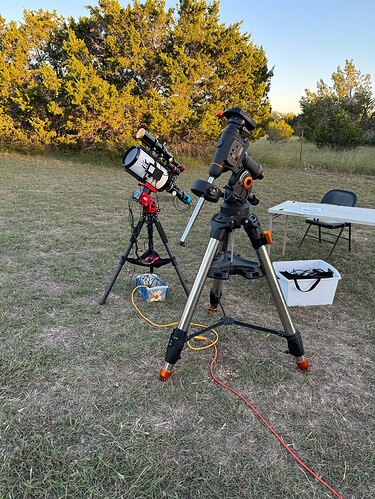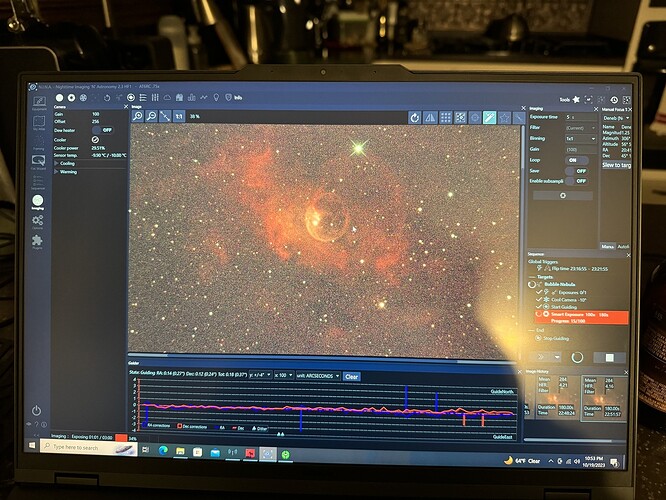That is a lot of features for the price, very interesting product indeed. Thanks for the review links. Need to watch the videos on the weekend, now for a quick DCS 2.9 spin ![]()
I like it when the FedEx driver rolls down the driveway…
The CGEM DX looks a little forlorn, stripped of her telescopes.
I have it up and running right now, imaging the Bubble Nebula.
That guiding graph is a thing of beauty….almost flat.
![]()
Wow, just wow… ![]()
First Light image with the new mount…
NGC7635 - The Bubble Nebula. Considering this was from the first night out with a new mount, I’m pretty happy with it.
It really looks like a soap bubble. Incredible.
How do you choose the targets? By magnitude or some other properties?
I have a few favorite targets, but I generally use a planetarium app (Sky Safari Pro) on my iPad and just browse around to see what looks interesting for the time I plan to be imaging.
It looks like my imaging marathon has come to an end due to weather, which is forecast to be cloudy for the next week or so. Still, I feel that I have been quite productive. There has been little time for simming!
Here is my attempt at the Helix Nebula (NGC 7293). This is a planetary nebula which is caused by a dying star shedding matter outward into space. So nothing to do with planets really, apart from their visual appearance though a telescope back in the 1700’s maybe. The dying star in question is seen right in the center of the nebula. I’m quite pleased with how this one turned out considering the light pollution I have to deal with to the south.
Edit> after another run at processing the image data…
I’m amazed by these shots, wow
It’s probably a stupid question, are the colours in your pics what you can see looking through your telescope??
In most cases human eyes are not nearly good enough to see any colors.
As @Aginor said…no. There is very little color to be seen through an eyepiece. I have seen a hint of some color when looking at the Dumbbell Nebula (M27) through a 30inch reflector telescope at a star party but it was just a hint, and it was a monster telescope.
The human eye gives the brain a snapshot of what it sees each fraction of a second. When looking at something dim, such as nebulae, galaxies etc, that really isn’t a lot of photons to play with. A camera collects photons over time to build an image. For the Helix Nebula image I shot 50 x 3 minute exposures and combined them (stacked) to give the final result. For the Elephant’s Trunk image (the good one) I shot 75 x 3 minutes.
One of the reasons I went to the dark side of the amateur astronomy hobby (a.k.a astro-imaging) is that I wasn’t blown away by what I could see when looking through the telescope.
Thanks! I told you it was a stupid question. ![]() It makes sense, as I post processing images I take RAW with my SLR, the data is there, just not in sufficient quantity.
It makes sense, as I post processing images I take RAW with my SLR, the data is there, just not in sufficient quantity.
I’m so glad you did, your shots are amazing.
Thanks…and it really isn’t a stupid question. I find it quite annoying when you see an entry level telescope at a store where the box is covered with beautiful color, high resolution photos of the planets, galaxies and nebulae. It sets the customer up for disappointment, at which point the scope sits in a corner gathering dust. Btw, if you plan on buying a scope, never buy from a high street store They usually sell cheap junk. Far better to save a little longer and buy something decent from a dedicated astronomy vendor.
I’m not sure how many of you guys would actually want to get into this hobby, but I think maybe a breakdown of the equipment I use, along with prices if you were to buy new might be useful. Astro-imaging, much like simming, can be as expensive as you want it to be.
At the least expensive end, we have the SeeStar, which I will give a review of here when I get it, but it looks to be an amazing way to enter the hobby.
Lets take one of the images I previously posted…
The equipment used, and price if bought new to create this image:
Telescope : AstroTech AT6RC - $479.95
Mount: Celestron CGEM DX. The newest version of the CGEM is $2049 (I would highly recommend getting the ZWO AM5 mount, which is what I just purchased. It comes in at a slightly higher price point, but your back will thank you - the CGEM is heavy.
My camera in the RisingCam ATR3CMOS08300KPA which is $599 (I purchased from AliExpress with no problems). The very best astro-images come from monochrome cameras using filters. I used to do that but the cameras and filters are more expensive. To be frank, I’m getting great results from my new color camera, and it is SO much easier than using a monochrome camera with filters.
I have a AstroPC Pro strapped to the telescope. This little PC basically runs everything. I use remote desktop to control it. $289 but if you have a laptop PC, you can get by with that.
For guiding, I use PHD2, which is free. My guide scope is a William Optics 66SD 66mm refractor. It’s complete overkill for the guiding role, but it can assume the duty of the main imaging telescope if I want to image a wide field target. A guide scope can be purchased for under $100. A decent guide camera can be purchased for about $150. If you buy a decent guide camera, it can often be used as a planetary imaging camera as well.
For this image I also used a dual band filter, which is great for nebulae and has the added bonus of allowing you to image where there is a lot of light polution or when the Moon is bright. There are a number of filters that fit the bill, but I went with the SVBony SV220 2 inch filter, that retails at $150.
So, lets total it all up…
AT6RC telescope $479
CGEM Mount $2000
Guide Scope $100
Guide camera $150
AstroPC $289 (optional if you have a laptop)
Dual Band Filter $150.
Total - $3168 USD.
Now, we need to talk about software to process the images. There are a lot of options these days. When I first started astro-imaging back in the early 2000’s the Rolls Royce of image processing software was Photoshop. These days it still is an excellent option but Adobe moved it to a subscription model. Still, for $10 per month, it represents excellent value for money, and won’t hit your wallet too hard (it used to be a $600 purchase). There are a number of freeware options that are quite powerful as well. Recently I splurged on PixInsight, which is extremely powerful image processing software specifically for astro-imaging. I also purchased some plugins which do an incredible job of sharpening and eliminating noise. For the whole package, including the plugins, it was a little under $500.
So, we are up to a total of $3668.
To put that in perspective, my last PC for simming was about $3500 not counting VR headset, joystick, pedals, throttle etc.
Hopefully that is useful info. Bottom line, if you are mildly interested, check out the SeeStar (if you can get your hands on one).
Paul steps off the soapbox and removes his Bad Influencer hat…![]()
Yeah, right ![]()
But that is a lot better than I was expecting. I will wait until the exchange rate is better and see how much that equipment is locally (or comparable kit if I can’t get that).
Where I live there is almost zero light pollution but I really can’t be bothered these days with faffing around with a manual equitorial mount to look at fuzzy images of planets through a cheap refractor… I may have just found a new hobby ![]()
I’m jealous about the light pollution. I am fortunate that it is dark enough at my location to still have the Milky Way visible, but civilization is marching towards me at an alarming rate. In a few more years I think I will either have to travel to a dark site or stick to narrowband imaging.
The SeeStar would be a great intro for you… but I would not be surprised if it leads you to something more capable down the road.
Hmmm, that first taste is cheap… and then. You sure that you don’t have a side hustle selling crack? ![]()
Seriously though. I currently only have a monopod for my camera, but now that I have a decent one, a good tripod and some long exposure shots on a clear night might be enough to get me started ![]()
Not as good as being in the ‘proper’ Outback. Most noticable for me is the lights of Canberra (about 40km NNW from here), But good enough for the Milky Way to ‘dominate’ on a moonless night and make out the Coalsack Nebula with a pair of binoculars.
And. I am at 1000m above Sea Level, so the slightly thinner atmosphere helps a bit as well.
I did some more work with the processing on the Elephant’s Trunk image. I think it’s time to step back and call it done. ![]()
After quite a few days of lousy weather (we desperately needed the rain), it’s clear out tonight. So…
The target is NGC7380 in Cepheus, also known as the Wizard Nebula, which I thought was appropriate for Halloween… ![]()
The 3 minute exposures are looking good, so hopefully I will get a nice final image.










